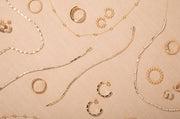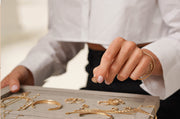The process of dreaming about, discovering, falling in love with, and then buying an engagement ring is endlessly exciting and an unforgettable moment in one’s life. Whether you're shopping solo or with your partner, the journey to finding the perfect diamond engagement ring should feel just as joyful as the proposal moment itself. The experience should be mostly romantic and fun, however, it is a considerable investment with a lot of factors to consider. With that in mind, we’ve compiled some essential tips and expert advice on buying an engagement ring. From understanding the 4 Cs to choosing the perfect setting and budget, we’ll touch on everything you need to know before making this important purchase!
Understanding the 4 Cs of Diamonds
Understanding the 4 Cs is a vital part of the engagement ring process. For example, a higher carat diamond may be less expensive than a smaller in size diamond with higher clarity – the 4 Cs will explain why this is the case and why striving for a well balanced stone is key!
Carat
Carat is the most straightforward of the 4 C's. A carat is the unit of measurement for a diamond's weight. Carats are divided into 100 “points.” For example, a "fifty pointer" signifies a half-carat diamond (0.50 ct). Carat weight shouldn't be confused with karat, which is a term used to measure the purity of gold.
Clarity
The clarity of a diamond is the absence of inclusions and blemishes, both internally and externally. Diamond inclusions, often unfairly called "flaws'' or "imperfections," are unique characteristics that give each diamond its distinct identity, much like a personal fingerprint. Natural diamonds, unlike diamond alternatives like lab grown diamonds, often possess these unique inclusions, adding to their distinct character and charm.
The clarity grade takes into account the size, location, quantity, and nature of these features and how they affect the diamond's appearance.
Most diamonds in the world possess some level of imperfection. It's essential to remember that clarity grading is conducted under 10x magnification, rendering many imperfections invisible to the naked eye. Dana Rebecca Designs believes in balancing clarity with other characteristics of the diamond to find the perfect combination of the 4 C’s.
Cut
The cut of a diamond refers to its proportions and finish. A diamond’s cut is widely recognized as the primary factor affecting its value, as it brings the stone to life! A well-cut diamond displays symmetrical precision with ideal depth, table, crown, and pavilion angles, with a flawless finish. Expert craftsmanship enables light to gracefully travel into the diamond, reflecting off its facets before bouncing back out, creating its scintillation and dazzling brilliance. Keep in mind that polish and symmetry also contribute to the overall appeal of any diamond shape. A round diamond is the only shape that receives an actual “Cut Grade” by the GIA Gemological Institute of America (GIA).
Color & The GIA Color Grading System
-
A GIA diamond is one that has been graded by the Gemological Institute of America (GIA) according to their diamond color grade standards used to determine diamond quality.
-
GIA is an independent, nonprofit organization that conducts research about various gems while educating gem professionals.
-
While many people assume diamonds are colorless, in reality, most have subtle tones of yellow or brown. The less color, the higher the grade value of the diamond will be (with some exceptions for fancy colored diamonds like blue, pink, or yellow).
The Most Popular Ring Settings
- Classic solitaire settings remain the most popular choice for engagement rings. With a single round center stone and a clean, minimal design, solitaires provide timeless elegance and endless versatility—especially when it comes to pairing with wedding bands.
- Skinny pavé bands are another favorite, offering a delicate, refined look with added sparkle thanks to the small diamonds set along the band.
-
Three-stone settings are also growing in popularity. We're seeing many round center diamonds paired with round side stones, but this style is highly customizable—any diamond shape can be beautifully featured in a three-stone design.
Metal Choices for Your Engagement Ring
The metal affects the diamond ring's appearance, durability, cost, and how well it complements your diamond or gemstone, in addition to your other jewelry pieces. Engagement rings are commonly made from either platinum or gold (rose gold, yellow gold or white gold).
Comparing Rose Gold, Yellow Gold, and White Gold
What is Rose Gold?
Rose gold is an alloy (mix) of 24K gold and copper which leads to its distinct pink hue. Occasionally, other metals are added to the mixture but copper combined with the gold is what’s primarily responsible for the rose color. People often ask if rose gold tarnishes? While rose gold is more durable than other gold alloys, proper care can help maintain its luster over time
What is Yellow Gold?
Yellow gold is an alloy (mix) of pure, 24k gold plus silver or copper which produces the traditional, warm yellow color. Yellow gold is often alloyed with other metals in order to increase its durability and strength. Solid gold pieces, like a classic yellow gold ring or a gold necklace, have been favored for centuries due to their timeless elegance and versatility.
What is White Gold?
White gold is made by alloying (mixing) natural, 24K gold with other metals which results in a white colored metal. Btw: a karat (abbreviated as ‘k’) is a measure of the purity of gold – pure gold = 24 karats.
White gold is alloyed with white metals such as nickel, palladium, silver, or zinc to change the metal color from natural yellow to white.
White gold is a classic choice for its’ beauty and durability, while rose gold offers a more unique or modern option. Yellow and rose gold bring warmth and tradition. Each metal offers its own strengths, so it’s important to choose one that best suits your style!
Durability vs. Aesthetic Appeal of Different Metals
Style and aesthetic preferences play a large part in selecting a metal for an engagement ring. How you set your ring will also impact the look of the metals – i.e. diamond shape/positioning. This is a quick rundown on each metal option for an engagement ring.
Yellow Gold
Yellow gold has a warm, timeless appeal and is often associated with tradition and elegance. It’s available in different karat options, with 18K being luxurious but softer, while 14K offers more durability.
White Gold
White gold is a classic choice for those who love a bright, modern look. It’s coated with rhodium for extra shine and is resistant to tarnishing. However, it may require replating over time to maintain its brilliance.
Rose Gold
This beautiful pink-toned metal has a romantic and vintage-inspired look. Its copper content gives it extra strength, making it more resistant to scratches compared to other gold engagement ring options.
Platinum
Platinum is one of the most popular and durable choices for engagement rings. Its natural white metal appearance doesn’t fade over time, and it’s also hypoallergenic, making it ideal for those with sensitive skin.
Silver
Silver is the most affordable precious metal option. While it provides a bright, clean look, it is also prone to tarnishing and requires regular maintenance to keep its shine.
Budgeting for Your Engagement Ring
So, how much should you spend on the ring? The budget is totally up to you! There is no reason to overextend yourself as there are plenty of options out there that can work with any financial parameters. DRD believes that it’s essential for each client to feel supported throughout the entire process, from start to finish, regardless of budget. We’re committed to finding ways to make your vision a reality without breaking the bank!
We often see couples splitting the costs, especially if the couple is already living together and sharing finances. Again, no right or wrong – do what works best for your situation!
Shopping for an Engagement Ring: Online vs. In-Store
Let’s state the obvious: shopping for your engagement ring is FUN! In our opinion, nothing beats the flutter of walking into a jewelry store and trying on ring after ring in order to confirm/decide what you love. However, some begin this process by browsing online first, collecting information and inspiration – this is a great plan!
An in-store engagement ring shopping experience at DRD is special. We begin with an initial consultation so that we have a solid grasp of your engagement ring desires. Those early conversations are all about understanding and further discovering each client’s unique vision! Sometimes a person knows exactly what they want from the very beginning and they stick with their original idea the entire time. Other times, the main idea remains at the core while some details change. It’s so important to try on all of the different diamond shapes and setting styles so that you can ultimately decide what you do (and don’t) like. Sometimes the dream ring is already made and could technically be purchased on the spot. Other times, a custom ring is the chosen path - DRD loves collaborating with clients in order to bring all ring visions to life!
How to Read Diamond Certifications
A diamond certification is an official document from a gemological laboratory that objectively details a diamond’s quality. Reading and understanding this report is essential to ensure you're getting what you paid for—not just sparkle, but verified value. The certification will detail the 4 Cs of the diamond as well as the measurements, polish symmetry and fluorescence. Also note the comments section that may reveal hidden issues not covered elsewhere.
Cleaning and Caring for Your Engagement Ring
We recommend cleaning your engagement ring with a mild soap solution and a soft toothbrush. Remember to also remove your ring before heavy activity or when applying lotions, perfumes, hairsprays and cleaning products so that you cut down on the build up. With the right care, a ring can and should last a lifetime (and beyond)!
We have covered a lot but maybe you still have questions? Or, maybe you’re excited to sip some bubbly in our showroom and try on rings? Schedule an appointment for one of our Chicago or New York locations – we can’t wait to meet you and would feel honored to be a part of your engagement ring journey. CHEERS!





